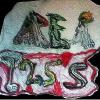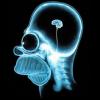NATURAL 5-HT1A Antagonists/Agonists/Modulators
It seems some people may have overlooked the obvious in regards to serotonergic modulation and the subsequent nootropic effects.
Besides WAY 100,135, WAY 100,635 and Lecozotan, I may have found one other notable ingredient.
Ginkgo Biloba acts as an agonist / modulator of 5-HT1A receptor expression, whereas Berberine acts as a presynaptic only agonist of 5-HT1A's - while at the 5-HT1A postsynaptic (where it releases ACTH, cortisol, prolactin etc) it acts to inhibit.
Thus berberine may be a useful tool not for increasing serotonergic neurotransmission through that pathway in particular, but for inhibiting excess serotonin and for reducing some of the negative neuroendocrine effects of serotonin. Notably, berberine also inhibited 5-HT2 type receptors and exhibited anxiolytic activity this way as well.
Berberine also inhibits PDE-5 mRNA - thus it may be the best natural tool for post and current SSRI-induced sexual dysfunction as well as in improving cognitive disturbances caused by serotonergic drugs.
http://area1255.blog...ntagonists.html
The aim of this study was to assess the anxiolytic effect of berberine (abbrev. BER) using two experimental anxiety models in the mouse. In the black and white test of anxiety, berberine (100, 500 mg/kg) produced an increase in the first time entry, time spent in the white section, and total changes between two compartments. On the other hand, in the elevated plus-maze test, berberine (100, 500 mg/kg) produced an increase in the time spent and arm entries in the open arms, and a decrease in the time spent and arm entries in the closed arms. Berberine (500 mg/kg) decreased locomotor activity in mice. Furthermore, BER at 100, 500 mg/kg decreased concentrations of NE, DA and 5-HT, and increased the concentrations of VMA, HVA and 5-HIAA in the brain stem. BER also attenuated the anxiogenic effect of WAY-100635, 8-OH DPAT and DOI and enhanced the anxiolytic effect of BUS, p-MPPI and RIT in the elevated plus-maze. These results suggested that berberine at 100 mg/kg had a significant anxiolytic-like effect, which was similar to that observed with 1 mg/kg diazepam and 2 mg/kg buspirone. The anxiolytic mechanism of BER might be related to the increase in turnover rates of monoamines in the brain stem and decreased serotonergic system activity. Moreover, BER decreased serotonergic system activity via activation of somatodendritic 5-HT1A autoreceptors and inhibition of postsynaptic 5-HT1A and 5-HT2 receptors.
OBJECTIVE:To further investigate the action mechanisms of berberine (Ber) and to assess the effects of Ber on the mRNA expression of phosphodiesterase type 5 (PDE5) in rat corpus cavernosum.
METHODS:After incubating with Ber for 1 or 3 h respectively, we examined the levels of PDE5 mRNA by reverse transcription polymerase chain reaction (RT-PCR).
RESULTS:There were PDE5A1 and PDE5A2 mRNA expressions in the rat corpus cavernosum with PDE5A2 as the dominant isoform. Ber could obviously inhibit the mRNA expression of the two isoforms in the rat penis and bring on a pronounced decrease in PDE5A2 (P < 0.01).
CONCLUSION:The present study indicates that the inhibitory effect of Ber on PDE5 mRNA expression, especially on PDE5A2, might account for its molecular mechanism for treating ED.
Edited by Area-1255, 10 September 2014 - 04:33 AM.




































































